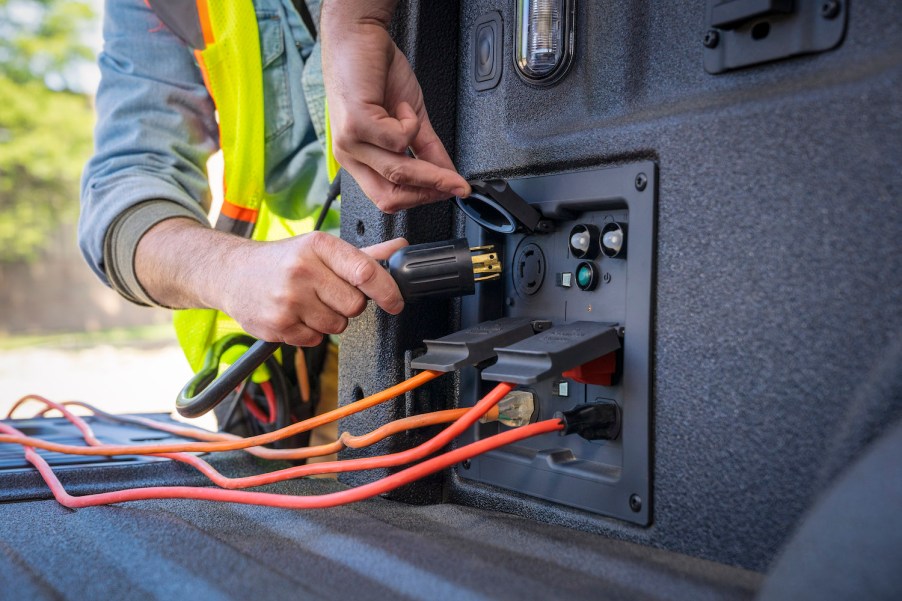
Only 1 Full-Size American Pickup Truck Offers a True Hybrid Engine
Sky-high gasoline prices are hurting pickup truck drivers at the pump. A hybrid drivetrain can improve a truck’s fuel economy by 20%, so you might think all the automakers would be clambering to sell them. But only one full-size American pickup truck currently offers a true hybrid engine option: the Ford F-150.
Is the F-150 PowerBoost worth it?
The EPA rated the F-150 PowerBoost hybrid at 23 mpg city/highway/combined. But reviewers are finding its fuel efficiency is actually higher in stop-go city traffic (up to 26 mpg) but not much better than non-hybrid F-150s on the highway.

Ford unveiled its F-150 PowerBoost drivetrain for the 2021 model year. The automaker sandwiched an electric motor/generator between its 3.5-liter twin-turbocharged EcoBoost V6 and ten-speed automatic transmission.
The electric motor adds 47 horsepower and 70 lb-ft to the gasoline engine. It is connected to a 1.5 kWh lithium-ion battery which it recharged whenever you hit the brakes. This powertrain can propel the truck to 60 mph in just 5.4 seconds.
One major benefit of the PowerBoost upgrade is its powerful, 120-volt inverter. Each of the two standard household outlets in its bed draws 20 amps from the under-bed battery pack. You can also configure the truck with a 240-volt, 30 amp outlet.
After driving an F-150 PowerBoost for a year, the team at TFL Truck concluded that the upgrade is only worth it for certain pickup owners. If you spend a lot of time in stop-go traffic, a hybrid F-150 may take a chunk out of your fuel bill. That said, the hybrid drivetrain does little to reduce mpg at highway speeds and thus may not always be worth its $4,495 price tag.
Who offers hybrid pickup trucks?
If you want a hybrid Ford truck you can choose either an F-150 PowerBoost or the compact Maverick. The only other full-size pickup truck currently offering a fully hybrid drivetrain is the Toyota Tundra. The all-new i-FORCE MAX is similar to the PowerBoost in both layout and output.

General Motors has experimented with several levels of hybrid powertrain in its Chevrolet Silverado/GMC Sierra pickup trucks. From 2009 through 2013, GM offered its 1500 pickup trucks with a 6.0-liter V8 and a special CVT transmission that incorporated an electric motor. This efficient hybrid was aimed at fleets but proved too slow for most mainstream sales and was discontinued.
Since its fifth-generation redesign, Ram has offered all the gasoline engine options in its 1500 with a mild hybrid system. This system, standard on the V6 and optional on the V8, combines the starter and alternator into a single unit. This eTorque unit is connected to the regular engine via a heavy serpentine belt. It can launch the truck from a standstill and recharge its 48-volt battery with regenerative braking. But it simply smoothes out the existing engine start/stop function and is not a true, full hybrid.
Nissan only offers its Titan with a 5.6-liter, naturally-aspirated V8. Similarly, you can only order a Nissan Frontier with a 3.8-liter V6. The next-generation Toyota Tacoma may borrow hybrid technology from the Tundra, but Toyota won’t release its new mid-size pickup until 2024.
The 2022 Toyota Tundra i-FORCE MAX hybrid is very similar to Ford’s PowerBoost

It is very likely that Toyota set the F-150 PowerBoost drivetrain as the benchmark for its latest premium Tundra engine. Just like the PowerBoost, the i-FORCE MAX is built around a twin-turbocharged V6. Toyota’s displacement is 3.44-liters, but the company advertises it as 3.5.
The i-FORCE MAX does not benefit from the PowerBoost’s lithium-ion battery. Instead, the hybrid Tundra must make due with a lead unit packaged under its rear seat. The i-FORCE MAX is only a $3,400 upgrade, but you’ll first have to opt for the expensive Limited trim. Ford, on the other hand, offers the PowerBoost on the entry-level F-150 XL.
See an extended review of the Ford F-150 PowerBoost in the video below:



